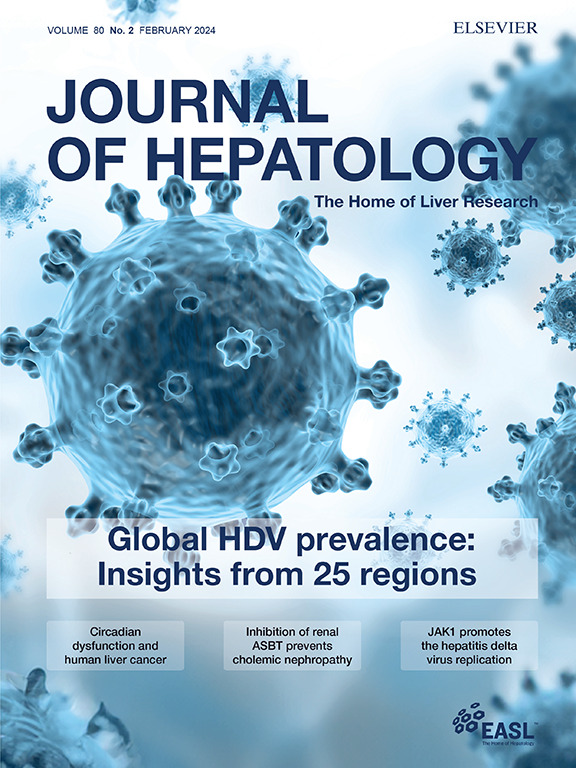Attenuation of the second peak of bimodal recurrence of HBV-related HCC after curative treatment in the antiviral era
IF 33
1区 医学
Q1 GASTROENTEROLOGY & HEPATOLOGY
引用次数: 0
Abstract
BACKGROUND
Recurrence in patients with hepatocellular carcinoma (HCC) treated with curative surgery or ablation follows a bimodal pattern, with early recurrence peaking at 6 months to 1 year, and late recurrence peaking at 3 to 4 years. We postulate the use of antiviral therapies could reduce late recurrence due to better control of chronic inflammation.METHODS
Patients with positive HBsAg and HCC (HBV-HCC) who received curative surgery or ablation from October 2000 to July 2017 were recruited from Prince of Wales Hospital in Hong Kong. The primary endpoint was recurrence-free survival (RFS). We conducted time-dependent survival analysis, 6-month and 12-month landmark analysis to evaluate the impact of antiviral therapy on overall recurrence and late recurrence, respectively. We conducted a secular trend analysis by stratifying the patients into early cohort (2001-2005) and late cohort (2011-2015), representing low and high prevalence of antiviral usage, to study changes in the hazards of recurrence.RESULTS
765 patients with HBV-HCC were recruited. Median RFS was 31.1 (95%CI 26.6-39.4) months for the entire cohort. In the time-dependent survival analysis, antiviral therapy is associated with improved RFS in the univariate model (HR 0.84, 95% CI 0.84 [0.74-0.99], p=0.042) and a similar trend is observed in the multivariable model (HR 0.86, 95% CI 0.86 [0.72-1.03], p=0.106). Baseline antiviral therapy significantly improved RFS in the 6-month (HR 0.75, 95% CI 0.75 [0.59-0.96], p=0.019) and 12-month (HR 0.62, 95% CI 0.62 [0.47-0.82], p=0.001) landmark multivariable analyses. Secular trend analysis showed fading of the second peak of recurrence in the cohort with high exposure to antiviral therapy.CONCLUSION
Following curative surgery or ablation, antiviral therapy against HBV is associated with reduction in late recurrence.

抗病毒时代hbv相关HCC治疗后双峰复发第二高峰的衰减
背景:接受根治性手术或消融治疗的肝细胞癌(HCC)患者的复发遵循双峰模式,早期复发在6个月至1年达到高峰,晚期复发在3至4年达到高峰。我们假设使用抗病毒治疗可以减少晚期复发,因为可以更好地控制慢性炎症。方法招募2000年10月至2017年7月在香港威尔斯亲王医院接受根治性手术或消融的HBsAg阳性HCC (HBV-HCC)患者。主要终点为无复发生存期(RFS)。我们分别进行了时间依赖生存分析、6个月和12个月里程碑分析来评估抗病毒治疗对总复发和晚期复发的影响。我们通过将患者分为早期队列(2001-2005)和晚期队列(2011-2015)进行长期趋势分析,分别代表抗病毒药物使用的低流行率和高流行率,以研究复发危险的变化。结果共纳入765例HBV-HCC患者。整个队列的中位RFS为31.1个月(95%CI 26.6-39.4)。在时间依赖生存分析中,在单变量模型中,抗病毒治疗与改善的RFS相关(HR 0.84, 95% CI 0.84 [0.74-0.99], p=0.042),在多变量模型中观察到类似的趋势(HR 0.86, 95% CI 0.86 [0.72-1.03], p=0.106)。基线抗病毒治疗显著改善了6个月(HR 0.75, 95% CI 0.75 [0.59-0.96], p=0.019)和12个月(HR 0.62, 95% CI 0.62 [0.47-0.82], p=0.001)里程碑式多变量分析的RFS。长期趋势分析显示,在高暴露于抗病毒治疗的队列中,第二次复发高峰逐渐消退。结论在根治性手术或消融术后,抗病毒治疗HBV可降低晚期复发率。
本文章由计算机程序翻译,如有差异,请以英文原文为准。
求助全文
约1分钟内获得全文
求助全文
来源期刊

Journal of Hepatology
医学-胃肠肝病学
CiteScore
46.10
自引率
4.30%
发文量
2325
审稿时长
30 days
期刊介绍:
The Journal of Hepatology is the official publication of the European Association for the Study of the Liver (EASL). It is dedicated to presenting clinical and basic research in the field of hepatology through original papers, reviews, case reports, and letters to the Editor. The Journal is published in English and may consider supplements that pass an editorial review.
 求助内容:
求助内容: 应助结果提醒方式:
应助结果提醒方式:


